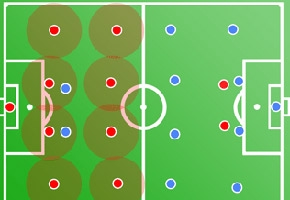Football News: Zonal Marking Gets A Bad Press

Image from: thedailydust.co.uk
Zonal Marking Gets A Bad Press
I was wondering whether I should do an article on zonal marking while reading the outcry on the Liverpool site following their defeat by Crystal Palace. There was so much ignorance shown regarding the system that it felt like I was listening to a Robbie Savage rant! The ridiculous comparisons with man to man marking, all delivered with misty eyes gazing back into a past where no one used this fancy dan foreigner muck of zones. Instead it was good old British man to man marking and no one ever scored against that system ever from a set piece. Apparently. But what finally convinced me to do this article was a throwaway remark made on our Rangers site, following a defeat to Celtic. The poster said "Ive got to admit that zonal defending gives me the fear". That was the clincher for me.
So let me start out by pointing out a few facts for those who have spent far too much time listening to Andy Gray bang on about the evils of zonal marking in commentary over the years.
Firstly, in a man-to-man system you still have a modicum of zonal marking. It is not a case of every man coming back and picking up a man, then any spare left over players with no one to mark gets out of the box. In fact, one of the things Andy Gray also harps on about constantly is the need to have someone on the posts, especially the back stick, which is zonal marking. The player has a zone, which is the post, and he is expected to stay in that zone until the threat is cleared. Often, in the days when man marking was commonplace, teams would set up with one man on the back post and one would take up position just in front of the near post. Sometimes there would be a guy on the near post too, but many managers just asked the man at the front post to drop in to the near post if the ball does not enter his zone and is not cleared immediately. I remember John Barnes at Liverpool being particularly effective in the role of protecting the front post.
Secondly, recent studies have concluded that the effectiveness of the corner has been reduced in recent years and a much lower percentage of corners result in goals in the modern game. That is not really all down to a change from man marking to zonal marking, there are numerous factors involved, such as an increase in goalkeeper protection, that will have an effect. However, it does suggest that the change over has not been a problem nor lowered the ability of teams to defend set pieces. Coaches follow trends in football because they see that something is working, that it is effective, not because they want to be fashionable. While dinosaurs in the media will bang on about things being better in the good old days, coaches on the sidelines are always looking for what they can do to improve their team's results. Clearly they see zonal marking is helping them to get better results or they would not be still using it.
Thirdly pundits spout a lot of nonsense about zonal marking and what it actually is. I have lost count of the number of times I have heard a commentator say that a player has just let an attacker move into another zone without a challenge and that is the problem with the system. Instead they should be questioning why the defender made no attempt to baulk the attacker's run. Especially when a player in an outer zone, so to speak, just stands and watches an attacker run towards the six yard box, such as when Emre Can left Christian Benteke run in to score for Palace. We hear inane and incorrect comments about him being left because the player was moving out of his zone, rather than anyone actually mentioning what he should have been doing. The outer players are meant to act as a screen, to hinder attackers from getting a free run to attack the ball in the six yard box at pace. When Tim Cahill was at Everton, he made a career out of getting a split second ahead of a man marker and being able to outjump taller defenders due to having a run on them. With a zonal system, he should be unable to get that run, as the screen should break up his momentum by getting in his way.
In the modern game man marking is much more difficult, as it really requires the marker being able to hold on to his man, grabbing his shirt, wrapping his arms around him, whatever it takes to stop him getting a run. Otherwise the marker will always be behind his man, as he has to react to what his man does. That problem can easily be intensified by a basketball-style pick and roll that a lot of clubs were incorporating into their attacking setpieces. That is why a lot more managers have moved over to zonal, it is more pro-active and also allows them more control over proceedings.
No system is perfect, there are always flaws that can be exploited by opponents, especially as today's robotic players are given such explicit instructions there is no room for them to react to any surprises. Even the smallest change in an opposition set up can completely flummox a defence and leave it vulnerable, until the coaching staff can get instructions on. That is far more of an issue in modern day football than the choice between zonal or man to man. Either way, even the best, most organised, defence can be beaten, but that is not because the system is rubbish. When you have a player showing the desire to win the ball Chelsea's Gary Cahill showed against Tottenham Hotspur, or the aerial prowess of Marouane Fellaini for Manchester United, there really is little a system can do. It is up to the players to show that same kind of desire to defend, the way Leicester City did last season to win the title. Sometimes the only thing that truly matters is the player's will to win and desire to stop or score a goal, no matter the cost.
Written by Tris Burke April 30 2017 05:08:18


